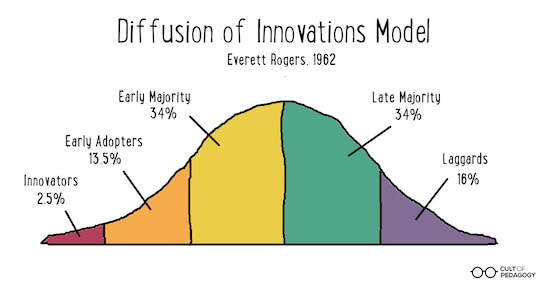Yesterday I wrote “Are you ready to ride the Monster Waves?“, talking about the massive dispersal changes that will come out of the pandemic, and that: “Some will ride this wave, others won’t believe it is there to ride even when it stares them in the face as they sit back on the beach. Still others will wait until further down the diffusion of innovations curve and wait their time.“
I realised as I wrote that post, that, though it is one of my favourite models, I had never written about it on this site in all these years of daily posting. So, I shall correct that omission today 🙂
I’ll first begin, though, with some thoughts on distilling to simplicity, as the Diffusion of Innovations model is such a beautifully expressed design that simplifies a concept to the essence. I’ll then explain the Diffusion of Innovations model as a story about phones, before closing by asking you to consider where you tend to sit on the curve and what this may mean for you in terms of readiness to change post-pandemic.
Distilling to Simplicity
Let’s look at “what is Innovation?”
Innovation is the practical implementation of ideas that result in the introduction of new goods or services or improvement in offering goods or services” ~ Wikipedia definition
“Simplicity is the ultimate sophistication” ~ Da Vinci, see my post of the same name here
““I made this one longer only because I have not had the leisure to make it shorter.” ~ Blaise Pascal, see my post: “If I’d had more time“
“I would not give a fig for the simplicity on this side of complexity, but I would give my life for the simplicity on the other side of complexity.” ~ Oliver Wendell Holmes, see my post “Learn deeply then distil to simplicity“
“Innovation is simply doing different things and doing things differently” ~ Tom McCallum
I’ve now been using this, my own definition of innovation, for years. People often “get it” and also find it takes the fear out of the word for them, so I love that. In terms of distilling to simplicity, then, if you have a longer definition for the word innovation, I encourage you to take more time to make it shorter.
Diffusion of Innovation levels and phones
Let’s consider each level of the model in terms of buying a new smart phone.
Innovators here are the first 2.5% of people around any change, any new idea, any new product. In terms of phones, they were the people who waited in line for days outside the Apple store to be the first to get the new release of each new iPhone.
Early Adopters follow the Innovators and are the next 13.5%. They love the new things and love to try new things, but they are not quite as devoted to the cult of Apple, so they will likely upgrade to the new iPhone within six months or so, as they are itching to try it and their love of the new overrides any rationality in them that may say “I’ll wait until I need a new one in a year or two”.
Early Majority people have waited until about 16% of the target market already have those iPhones. They like the new, and also are more cautious, likely waiting to see what their Innovator and Early Adopter friends (and, in the modern world, the online long term reviews) have to say. They will definitely upgrade when their phone company phone contract expires, likely in one to two years, by which time this 34% of people mean that this innovation has now diffused through 50% of the target market.
Late Majority people won’t jump in for quite a while, likely through feeling the need to catch up with their peers and/or being abundantly cautious around change, often couched in language like “let’s see whether people are still using it in a few years” or any range of reasons they give themselves to justify waiting a little longer. BTW, once 50% of people are buying into a new product, changes are the reasons the Late Majority aren’t joining in have little to do with the product, the innovation, and much to do with their own fear of change.
Laggards? Well, if they could still find a rotary phone attached to the wall with a cable, they’d still use one. I have a family member who has a smartphone as “the phone company gave me one” (ie they bought one on a contract) but they made the phone company disable data on it. After all “what would I do with it?”. Do as I do, avoid any effort to convert them.
Readiness to change, post-pandemic
To me the six most dangerous words in business are “we’ve always done it this way”.
The pandemic forced many changes on us rapidly. Through that, we remembered how adaptable we are, as a society, as businesses, as individuals. Some want to race back to the way things were. Others want to “go back to better”, a beautiful expression I heard recently. Some want radical change and fast (innovators), others only a little change and slower (early or later majority).
I seek here not to suggest which path is right for you, simply to highlight that change is coming, and for you to be aware of your natural style (Innovator, Early Adopter, Early Majority, Late Majority, Laggard) and ask yourself if that serves you and those you lead.

